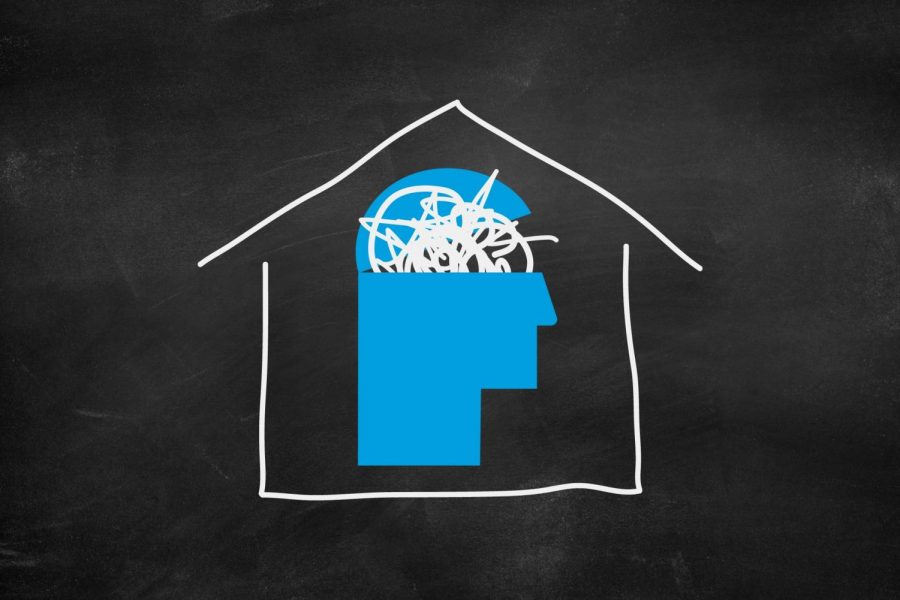COVID-19 has had a mental impact on the FHC community
For FHC students, teachers, and parents, it’s no secret that there is a new dynamic in the building this school year. Nonetheless, education moves on—whether that be through choosing to go completely online, through hybrid, or back to full in-person—students had options to move forward through the COVID-19 pandemic.
Sophomore Sophia Badaluco embraced online learning at the beginning of this school year. Going back to March 13th, 2020, Sophia was particularly more socially-isolated than most.
“First off,” Sophia said, “I live far from school, so I’m not within walking distance. This is a disadvantage because I’m not around Ada [or near my friends]. Also, I don’t have my license yet. If I could have, on my own time, then I would have gone and seen people, but I couldn’t do that yet.”
This is the case for many underclassmen, especially those who may live farther away from friends. If parents chose to allow their children to spend time with a close circle of friends over quarantine, there are also accessibility and time management factors.
Like what Sophia experienced, Psychology teacher Brian Pierce believes that limited exposure to friends can take a toll on us. While nobody was completely isolated since they still had their families surrounding them, we need a variety of interactions to have a healthy state-of-mind.
“Our friends are people that we have chosen to surround ourselves with,” Pierce said, “They help us in all sorts of ways—we choose friends for a variety of mental health reasons. There are generally three types of friend values: Stimulation Value, which is when a friend is interesting or imaginative and can introduce us to new ideas or experiences, Utility Value, which is a friend who is cooperative and helpful, and who seems willing to give his or her time and resources to help us achieve our goals, and Ego-Support Value, which are friends who are sympathetic and encourage us when things go bad. We need all of these [interactions], so when we are limited in our exposure to them, it can take a toll on us.”
Whether students have pre-existing mental health problems or not, quarantine was very much capable of either amplifying these issues or creating new ones. For Sophia, being a significantly friendly person by nature, the lack of “normal” social connections was a mental barrier she had to cross while isolated.
“I wasn’t ideal because I couldn’t see anyone or be around anyone,” Sophia stated. “I only talked to my family, and that was really it, but I would spend a lot of time on my phone talking to friends. [I would do] anything I could to talk to my friends, so my screen time was much higher than normal. Mentally it was difficult because I didn’t see people for so long, and it’s hard not talking to people when you are used to talking to everyone every single day.”
Dissimilar to Sophia, junior Sunny Xu never experienced a compelling amount of loneliness. He never felt distanced from his friends; in fact, he both reconnected with old friends and made new ones through utilizing social media while socially isolating himself.
“[Quarantine] really hasn’t affected my mental health at all,” Sunny said. “One of the reasons that I’m socially isolating is so that I can stay safe. Although the death rate is very low, you can’t ignore the fact that there is one. And, because of that, I’m just trying to stay as safe as I can. There’s always time to hang out with friends after the pandemic is over, so why rush and hang out now?”
English teacher Lisa Penninga upholds a similar state-of-mind to Sunny when she talks about her particular situation during this pandemic. Penninga’s youngest son has had three open-heart surgeries and has multiple congenital heart defects. He is especially vulnerable to COVID-19, making Penninga all the more cautious about socially isolating herself and her remaining family-of-four.
“While he looks and acts like a crazy, happy eight-year-old,” Penninga said, “this pandemic is kind-of terrifying for us because if he were to get COVID-19, his doctors believe that it would be very challenging for him to fight the virus.”
Nonetheless, this hasn’t stopped Penninga and her family from finding inventive ways to spend their time. And, while her family is spread around the house during work and school hours, she has found that they have only grown closer throughout this experience.
“[My husband and I] really teach [our kids] that gratitude is most important,” Penninga shared, “so we always try to look at what we do have, instead of what we are unable to do. I think [our kids] are handling it really well. I have three boys—and they are best friends—so they love to hang out together, and they do a lot of the same activities and have the same passions.”
While the state of the world may be overwhelming to people’s physical health and their mental health, it is essential to look to the future for hope. For some, this means riding out the pandemic within the safety of their inner-circles, and, for others, this could mean slowly blending back into society from quarantine. Still, respect is key to the values that individuals hold about the pandemic.
“The most difficult thing [about living in this pandemic] is transitioning from normal life to the life I’m living right now,” Sunny stated. “I just had to adapt to various situations presented to me and find solutions for everything on my own. Other than that, I still stay in touch with my friends and even made new ones. After changing my lifestyle, this pandemic isn’t really that hard to live in.”
At the start of the pandemic, many individuals were speculating that the first shutdown was the worst that could happen; however, others are starting to question—some developing this attitude due to the anxiety over the return to school—what a second shutdown would look like now.
Although some of these situations are way out of the control of both the FHC community and the individuals within it, Pierce believes that there are steps that can be taken to contribute to a more positive state-of-mind.
“Keep a journal of things that are going on,” Pierce stated, “Make a checklist every morning and stick to it. Make sure you go outside for part of the day, whether that is to go for a walk or simply sit on the porch and read. Interact with your sibling; this will not only help you but will help your sibling, especially if they are younger than you and more than likely look up to you. Get a puzzle out. Email a teacher to just check-in. We have to try and keep our minds occupied a little bit, especially if we are someone who already struggles with things [such as] anxiety and depression.”
Still, according to Pierce, it is a joint effort from both sides of the screen that will make all the difference. If COVID-19 were to shut down the school again, FHC students, parents, and staff need to work together to ensure this pandemic’s best possible outcome.
“If we go back to quarantine,” Pierce said, “I think students at FHC are very lucky to have teachers that care about them tremendously, that understand there is a curriculum to be taught, but also a human on the other side who could be struggling with something in their lives Students need to communicate more, and parents need to be more involved when there is quarantine happening—it is always a team effort to make sure the world continues to go around.”

Kelsey Dantuma is a senior entering her third and final year on staff for The Central Trend. In all honesty, Kelsey has found a home through writing for...




























































































Chip Perschbacher • Sep 30, 2020 at 8:25 am
Kelsey, A very insightful article that I thought was informative, well written and “spot on”! Thank you and congratulations!